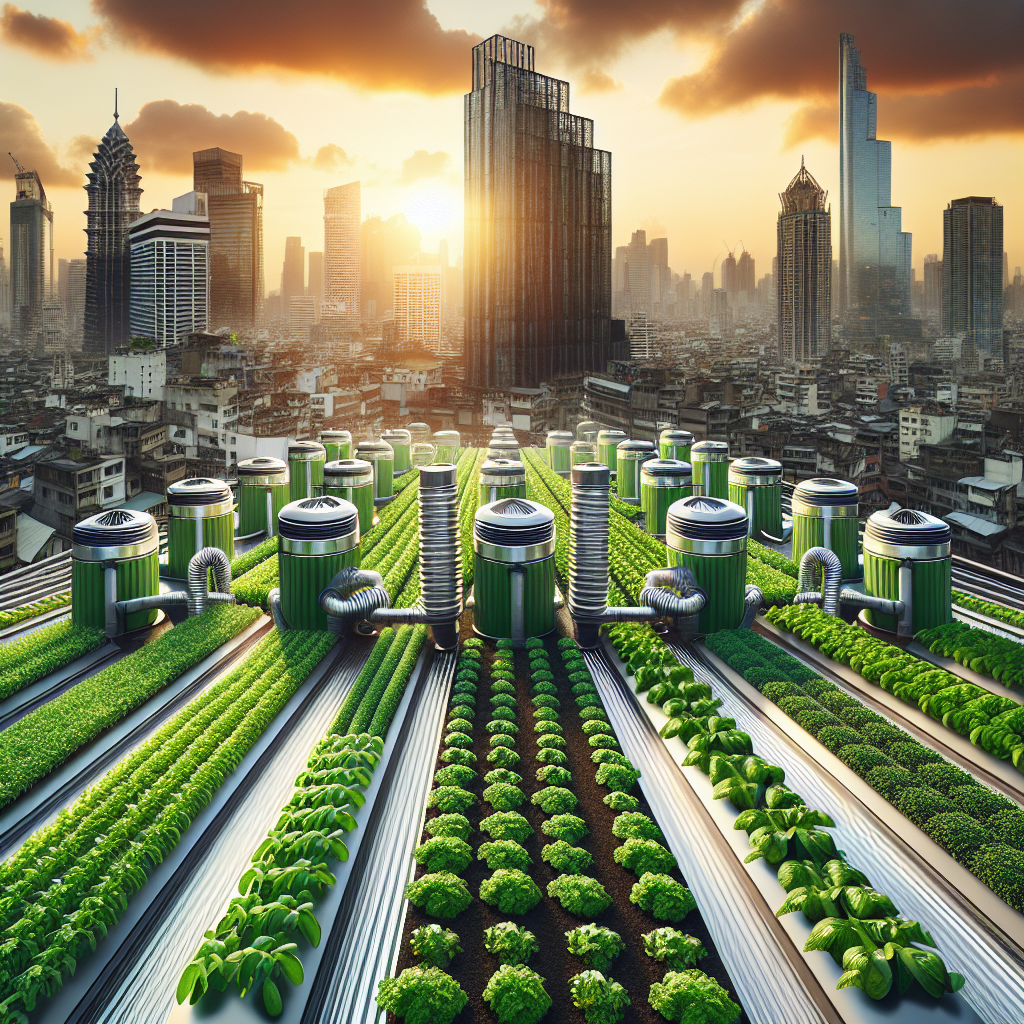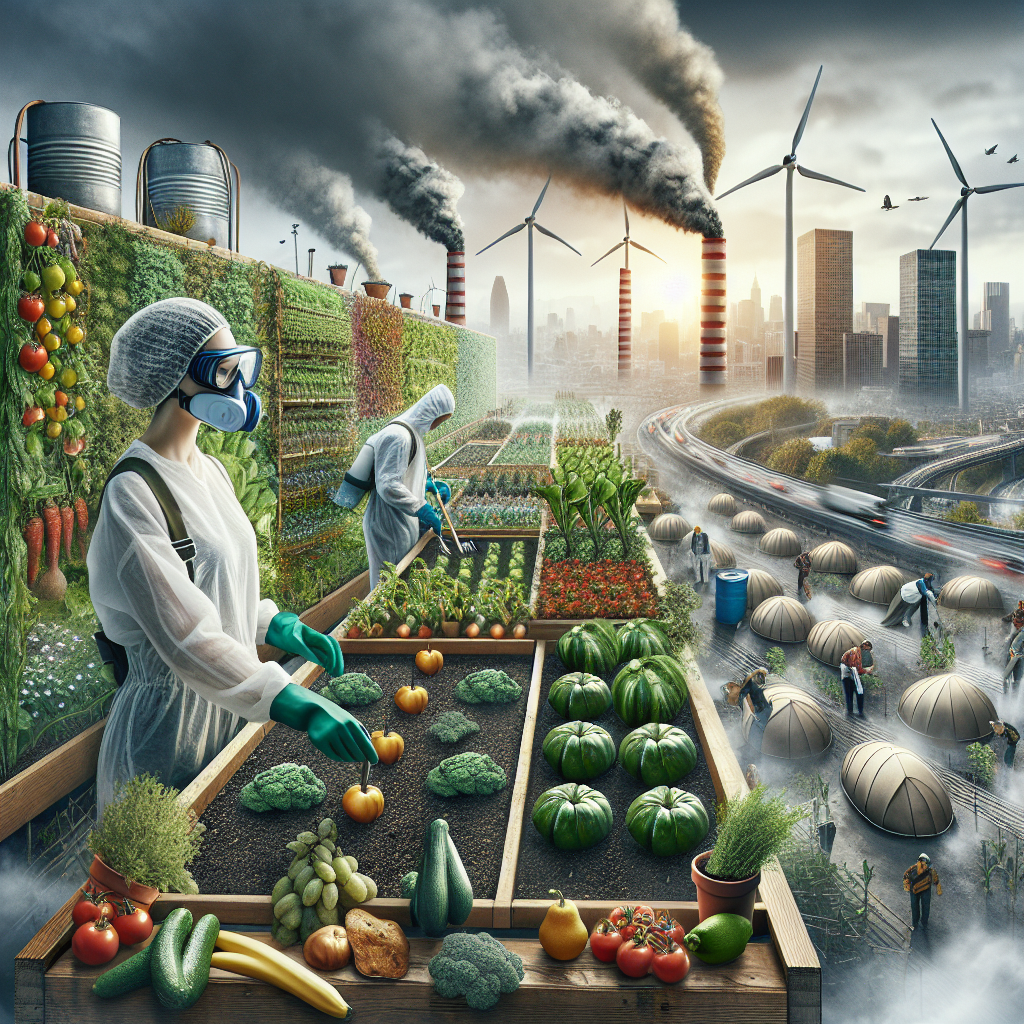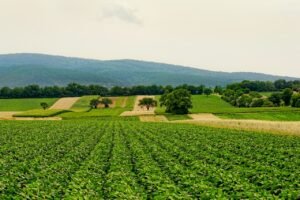
Growing your own urban crops can be a fulfilling and rewarding experience. However, with the abundance of air pollution and potential contaminants, it is crucial to take necessary steps to protect your crops. In this guide, we will explore practical tips and strategies to minimize air pollution and contaminant risks, allowing you to grow healthy and nutritious crops right in the heart of the city. From choosing the right location to implementing effective air filtration systems, this article aims to provide you with the knowledge and tools to safeguard your urban crops and enjoy the bountiful harvest they bring.

Selecting the Right Location for Urban Crops
When it comes to urban farming, selecting the right location is crucial for the success of your crops. One important factor to consider is the Air Quality Index (AQI) data of the area. AQI data provides information on the air quality, including levels of pollutants such as particulate matter, ozone, and carbon monoxide. By analyzing AQI data, you can choose a location with better air quality, minimizing the risk of your crops being exposed to harmful pollutants.
Another aspect to consider is the industrial activities in the area. Analyzing local industrial activities can give you insights into the potential sources of air pollution that might affect your crops. Industrial emissions can release pollutants such as sulfur dioxide, nitrogen oxides, and volatile organic compounds, which can have detrimental effects on plant growth. By selecting a location away from heavy industrial areas, you can reduce the risk of your crops being exposed to high levels of pollution.
In addition to industrial activities, evaluating the proximity to high-traffic areas is important. Vehicles are a major source of urban air pollution, emitting pollutants like nitrogen dioxide and particulate matter. Traffic congestion can lead to higher levels of pollution near busy roads. By choosing a location away from high-traffic areas, you can minimize the exposure of your crops to vehicular pollutants, ensuring their health and quality.
Choosing Resilient Crop Varieties
In order to protect your urban crops from air pollution and contaminants, it is essential to choose resilient crop varieties. Opting for pollution-tolerant plant species is a wise decision as they have the ability to withstand and thrive in polluted environments. These varieties are equipped with mechanisms to detoxify and eliminate pollutants, making them resilient against the adverse effects of air pollution.
Selecting varieties with pest and pathogen resistance is equally important. Air pollution can weaken the immune system of plants, making them more susceptible to pest infestations and diseases. By choosing crop varieties with natural resistance to pests and diseases, you can minimize the need for chemical pesticides and herbicides, reducing the risks associated with their use.
Furthermore, prioritizing indigenous or native crops is an effective strategy to ensure the resilience of your urban crops. Indigenous or native crops have adapted to the local environment over generations, making them better suited to the prevailing conditions, including air pollution levels. These crops are often more resistant to pests, diseases, and environmental stresses, making them a sustainable choice for urban farming.
Implementing Protective Physical Barriers
To further protect your urban crops from air pollution, implementing protective physical barriers can be highly beneficial. Constructing greenhouses or using polyethylene covers creates a controlled environment for your crops, shielding them from external pollutants. Greenhouses not only provide protection from air pollution but also regulate temperature, humidity, and sunlight, creating optimum growing conditions.
Deploying row covers and shade cloth is another effective method of creating a physical barrier. Row covers are lightweight fabrics that can be placed directly over the crops, providing a protective shield against pests and reducing exposure to air pollution. Shade cloth, on the other hand, can be used to regulate sunlight intensity, preventing excessive exposure and potential damage to the crops.
Installing windbreaks and barriers can also help in mitigating the effects of air pollution on your urban crops. Windbreaks reduce the impact of strong winds, which can carry pollutants and cause physical damage to plants. Barriers, such as hedges or fences, can create a buffer zone between your crops and potential sources of pollution, acting as a shield against airborne contaminants.
Understanding Air Pollution Sources
To effectively protect your urban crops from air pollution, it is important to understand the sources of pollution in your area. By identifying industrial emissions and chimneys, you can assess the potential impact on your crops. Industrial emissions are known to release pollutants that can have harmful effects on plants, so it is crucial to know their proximity and the types of pollutants being emitted.
Recognizing vehicular pollutants is also vital in protecting your urban crops. Vehicles emit pollutants such as nitrogen dioxide, carbon monoxide, and particulate matter, which can negatively affect plant health. Understanding the extent of vehicle traffic and its proximity to your crops will help you devise strategies to minimize exposure and potential damage.
Apart from industrial and vehicular sources, considering natural sources of pollution is equally important. Natural sources like wildfires, pollen, and dust storms can introduce pollutants into the air. Being aware of these sources and their seasonal patterns can help you take proactive measures to safeguard your crops during times of increased pollution levels.

Minimizing Urban Air Pollution
Alongside protecting your crops, it is essential to contribute to minimizing urban air pollution as a responsible urban farmer. One way to achieve this is by reducing vehicular emissions. Promote eco-friendly transportation options such as cycling, walking, or carpooling within your community. Encourage the use of public transportation and electric vehicles to reduce the overall emissions in your area.
Implementing regulations on industrial emissions is another effective approach to minimize air pollution. Engage with local authorities, policymakers, and environmental organizations to advocate for stronger emission standards and stricter enforcement. Support initiatives that promote cleaner production methods and encourage industries to adopt greener technologies.
Promoting renewable energy sources is a sustainable strategy to minimize air pollution. Support the use of solar panels, wind turbines, and other renewable energy systems in your community. By transitioning towards cleaner energy sources, you can contribute to reducing the overall emissions that contribute to air pollution, creating a healthier environment for your crops and the community as a whole.
Controlling Contaminant Risks
In addition to air pollution, the presence of contaminants in soil and water can pose risks to your urban crops. To ensure the health and safety of your crops, it is important to control these risks effectively. Start by testing the quality and composition of the soil in your growing area. Regular soil testing helps in identifying any contaminants that might affect plant growth and allows you to take appropriate measures to address them.
Monitoring water sources for contamination is equally important. Water used for irrigation should be free from pollutants, chemicals, and heavy metals that can be harmful to both plants and consumers. Regular water testing ensures the safety of your crops and prevents the accumulation of contaminants in the soil.
Avoiding chemical pesticides and herbicides is crucial to minimize contaminant risks. Chemical pesticides can leave residues on crops and in the soil, impacting both plant health and human health. Opt for organic and environmentally-friendly pest control methods such as integrated pest management (IPM), crop rotation, and biological control. These methods reduce the reliance on harmful chemicals and protect your crops from contaminant risks.

Proper Air Circulation and Ventilation
To create a healthy growing environment for your urban crops, proper air circulation and ventilation are essential. Design layouts that allow for adequate air flow between your crops. Dense planting arrangements can restrict air circulation, creating a favorable environment for diseases and reducing overall plant health. By spacing your crops appropriately, you promote better air circulation, reducing the risk of moisture-related diseases and promoting healthy plant growth.
Maintaining optimal ventilation systems is equally important. In enclosed growing structures such as greenhouses, ensure proper ventilation systems are in place. These systems help regulate temperature, humidity, and carbon dioxide levels, creating a balanced and favorable environment for your crops. Monitor and maintain ventilation equipment regularly to ensure efficient functioning and minimize the risk of stagnant air and humidity-related issues.
Strategically placing crops can also improve air circulation in open fields. Consider the prevailing wind patterns and position your crops accordingly. Avoid planting in areas that are prone to stagnant air or where pollution sources are likely to have a greater impact. By strategically placing your crops, you can maximize air movement, reducing the risk of pollution-related damage.
Managing Soil and Water Quality
To ensure the long-term health and productivity of your urban crops, proper management of soil and water quality is crucial. Utilize compost and organic fertilizers to improve soil fertility and structure. These natural amendments not only provide essential nutrients for your crops but also enhance soil health, water retention, and microbial activity. By enriching the soil with organic matter, you promote nutrient cycling and balance, contributing to the overall well-being of your crops.
Practicing crop rotation is another effective method for maintaining nutrient balance in the soil. By alternating crops with different nutrient requirements, you prevent the depletion of specific nutrients and reduce the risk of nutrient imbalances. Crop rotation also helps in naturally managing pests and diseases, reducing the need for chemical interventions.
Filtering and treating irrigation water can greatly contribute to maintaining water quality for your crops. Install appropriate filtration systems to remove contaminants and sediment from irrigation water. Consider using technologies like drip irrigation or rainwater harvesting to minimize water wastage and reliance on municipal water supplies. Treating irrigation water, if necessary, ensures that your crops are receiving clean and uncontaminated water, reducing the risk of crop damage and contamination.

Monitoring and Early Detection
Regularly inspecting crop health and development is essential to detect any potential issues early on. Regular visual inspections allow you to identify signs of stress, diseases, nutrient deficiencies, or pest infestations and take prompt action to address them. Be vigilant in observing your crops for any abnormalities such as yellowing leaves, wilting, or unusual growth patterns.
Utilizing pest and disease monitoring systems can assist in early detection and prevention. Implement integrated pest management (IPM) strategies that include regular monitoring of pest populations, trapping methods, and beneficial insect release. Disease monitoring systems, such as visual assessment or diagnostic tools, help in identifying infections and take necessary measures to prevent further spread. By actively monitoring your crops, you can intervene at the earliest signs of trouble, mitigating potential damage and losses.
Implementing remote sensing techniques can also aid in the early detection of crop stress and disease outbreaks. Utilize satellite imagery, aerial drones, or other remote sensing technologies to monitor crop health, assess vegetation indices, and detect changes in plant growth patterns. These techniques provide valuable insights and allow for timely interventions, minimizing the impact of potential threats on your crops.
Collaborating with Local Communities
Collaborating with local communities is an important aspect of urban farming. By participating in urban farming coalitions or community gardens, you can exchange knowledge, resources, and best practices with fellow urban farmers. These collaborations provide opportunities to learn from others, gain insights into specific challenges and solutions, and strengthen the urban farming community.
Engaging with neighbors and residents is crucial for building support and fostering a sense of community around urban farming. Organize events, workshops, or open days to showcase your urban farm and educate others about sustainable farming practices. Encourage community involvement by offering volunteering opportunities or organizing educational programs for schools and local organizations. By actively engaging with your community, you can raise awareness about urban farming, promote environmental responsibility, and garner support for your efforts.
Sharing knowledge and best practices is essential for the growth and success of urban farming. Document your experiences, successes, and challenges as an urban farmer and share them through blogs, social media, or local publications. Offer guidance and support to aspiring urban farmers while also learning from their experiences. By sharing your knowledge, you contribute to the collective understanding of urban farming and inspire others to embark on similar initiatives.
Conclusion
Protecting your urban crops from air pollution and contaminants requires careful consideration of various factors. By selecting the right location, choosing resilient crop varieties, implementing protective physical barriers, understanding air pollution sources, minimizing urban air pollution, controlling contaminant risks, ensuring proper air circulation and ventilation, managing soil and water quality, monitoring and early detection, and collaborating with local communities, you can effectively safeguard your crops and promote sustainable urban farming practices. Remember, by taking proactive measures to protect your crops, you contribute to the well-being of your community and the environment as a whole.








